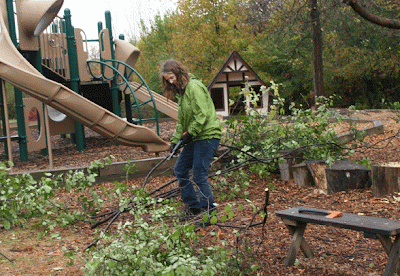Some of you may remember my posting last April when I visited the amazing Four Winds Waldorf School in Warrenville, IL, on the outskirts of Chicagoland. I'd visited then because I had an invitation to give a wattle fence workshop, and wanted to check out the location. And I was curious why a private school wanted a wattle fence around a playground. After my tour and visit with Marianne Fieber, the school Administrator, I understood. It's not your ordinary school but one in which the students and children are as involved and engaged as the teachers are.
A wattle fence to surround the playground was Marianne's vision, something she's been working toward for a couple of years. She said she had seen a wattle fence at another Waldorf School and thought it would be perfect for the school in Warrenville. (To learn more about Waldorf Schools world-wide, visit their link, it's a very interesting concept). One of the aspects of the school that I admire is the teacher a child starts with in kindergarten or first grade, is the teacher for that class through all eight grades. There's also a connection for the students with nature, plants, gardening and the seasons also, and I really admire that, too.
So the workshop. We'd planned on having 15 or 20 people, for 2 workshops, one on Saturday and one on Sunday. Garden Writer of America members around Chicago were invited, as well as local media people, in hope of giving the school and the project some publicity. Possibly because the School had just had a harvest festival, or who knows why, the turnout was pretty disappointing. At 9:00 a.m. on Saturday, starting time, no one showed up. It was just Marianne and me, and a bit of misting rain. She made some calls, a couple of folks were on their way. By about 9:30, we had 4 more people, including 7 year old Ezra who was anxious to learn about the project. Then it began to rain.
 |
| In the rain, everyone struggled to cut saplings from the school grounds. That's Bruce Cooper, the 7th grade teacher and Rich Hill, one of the parents, working with soggy wet saplings. |
 |
| Beginning to weave the saplings between the posts. It takes a lot of saplings to do this project - which is why we were hoping for a large group. We were only able to do about one fourth of the fence Marianne envisioned, but we made a good start. |
 |
| This was the only time that Ezra sat down. Most of the time he was pruning the limbs off saplings as his father and the 7th grade teacher, Bruce, brought them in from the woods. Ezra kept us all cheerful even though we were soaking wet. |
 |
| Lynn Hill, Ezra's mother, cutting saplings to size. |
 | |
| Marianne Fieber, school Administrator, worked tirelessly to see the fence take shape. |
Corona Tools donated a pair of loppers and a pair of pruners to be given away at the workshop. This is the Hill family, Lynn, Rich and Ezra, who worked really hard all day and were pleased to take home the great Corona lopper. Pat Clancy, who was the recipient of the Corona pruners, had just left to go home and find dry clothes but we got the pruners to her afterward.
 | ||||
| Ezra mastered the use of the tools and was already making plans with his mother for what kind of bentwood fence he would build in their home garden. Corona Tools provided a set of loppers and pruners for the workshop. |
And here's a section of the completed fence. The goal was to build a barrier, one that could be seen through, walked around, but a visual barrier for the smaller children. We accomplished that in spite of the obstacles.
Tired, wet to the skin, we cleaned up, everyone pleased with what we had accomplished for the school. Thank you, Marianne for your vision, and to the workers for their help. This is a very unique school and it was a joy to be a small part of it. And a big thanks to Corona Tools for their generous donation!







4 comments:
Love this,what great pictures! Some years ago my gang cut bunches of our basket willows and they made some small wattle fences for around their individual gardens. Sure, the fence sections were more than a little wonky, but they were very proud of themselves! What a lucky school to have you come for a visit :)
Wattle is one of my favorite garden features. Most uprights quickly rot in my climate or are eaten by termites. I started using rebar posts. Any sapling weavers will last about 3 years before the dog chases the cat through. Redbud is my fav; I've even used smilax lengths. Sometimes I make a little trellis with posts closer and the weavers farther apart secured with raffia.
Neat-I'm feeling a new project coming on for next summer.
I could not be more impressed with this fence. It turned out great and looked like a lot of fun to build.
Post a Comment